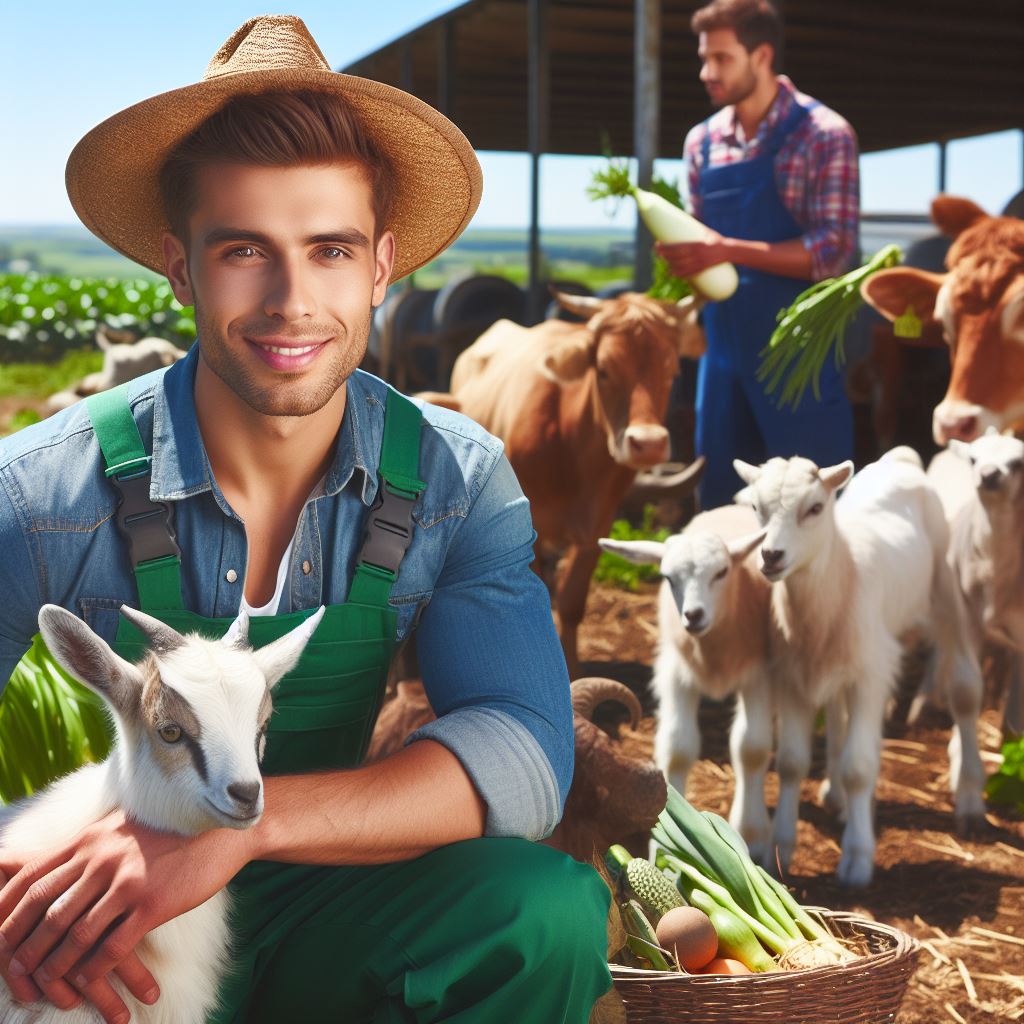Introduction
Family farming has been a cherished tradition for generations, carrying with it a unique and undeniable charm.
In this blog post, we delve into the success story of a specific family farming operation that triumphs on a mere 5-acre plot of land.
The humble countryside, their 5-acre domain, has become the backdrop for a remarkable family farming tale.
Through sheer tenacity and unwavering dedication, this close-knit family has transformed their small piece of earth into a flourishing agricultural oasis.
From the crack of dawn until dusk, the family toil away, tending to crops and livestock with unyielding determination.
Their days are filled with action and purpose, as they nurture the land that sustains them and fuels their aspirations.
Through intelligent planning and modern farming practices, they have optimized their limited land, achieving remarkable yields and profits.
Their success can be attributed to their acute awareness of market demands and their ability to adapt swiftly.
Yet, it isn’t just the financial gains that define their success.
This family is truly living their dream, cherishing the opportunity to work together while enjoying the bounties of nature.
The invaluable lessons of perseverance, reliance, and togetherness resonate deeply within them.
Their story inspires others, reminding us that family farming is more than a means of survival.
It is a way of life, strengthening bonds and nurturing a deep-rooted connection to the earth.
The tale of their 5-acre success reminds us that dreams can be achieved, even on the smallest of scales.
In a world driven by industrial agriculture, this family’s triumph stands as a testament to the enduring allure and unlimited potential of family farming.
Their story illuminates the simple yet profound truth that with passion, hard work, and unity, anything is possible.
As we bid farewell to this mesmerizing family farming tale, we are left with a renewed sense of admiration and respect for those who dedicate their lives to the noble art of cultivating the land.
May their story continue to inspire others to embrace the spirit of family farming and forge their own paths to success.
Background
Family farms have been a cornerstone of the agricultural industry throughout history.
These small-scale operations have played a significant role in providing food for communities and supporting local economies.
However, in today’s fast-paced and competitive market, family farms face numerous challenges that threaten their survival.
Nonetheless, sustainable and organic farming practices offer hope for a prosperous future.
One of the primary reasons why family farms are essential is their contribution to local food production and security.
These farms cultivate a wide range of crops and raise livestock, ensuring a diverse and reliable food supply for the community.
Moreover, family farms often prioritize quality over quantity, producing fresh and nutritious food that is in high demand.
In addition to local food production, family farms play a vital role in supporting the economy.
They create employment opportunities both directly and indirectly, from farmers and farmworkers to suppliers and distributors.
By investing in family farms, communities can stimulate economic growth and reduce dependence on large-scale industrial agriculture.
Challenges faced by small-scale farms
Sadly, small-scale farms face numerous challenges in today’s agricultural market.
One of the most significant hurdles is the competition from large corporate farms that benefit from economies of scale.
These industrial operations can produce vast amounts of food at lower costs, making it difficult for family farms to compete.
Another challenge faced by family farms is the lack of access to resources and markets. Limited capital and land availability often restrict the growth and expansion of these farms.
Additionally, accessing local and global markets can be challenging, as they are often dominated by large corporations with extensive distribution networks.
Furthermore, family farms often struggle with the increasing costs of production, including fuel, fertilizers, and machinery.
These expenses put additional pressure on already limited financial resources, making it harder for family farms to make ends meet.
Significance of sustainable and organic farming practices
In the face of these challenges, sustainable and organic farming practices offer a beacon of hope for family farms.
Sustainable farming emphasizes the preservation of natural resources, such as water and soil, for long-term productivity.
Organic farming, on the other hand, avoids the use of synthetic pesticides and fertilizers, prioritizing natural and eco-friendly alternatives.
Transform Your Agribusiness
Unlock your farm's potential with expert advice tailored to your needs. Get actionable steps that drive real results.
Get StartedBy adopting these practices, family farms can not only mitigate environmental impacts but also meet the growing demand for organic and sustainable food.
Consumers today are increasingly conscious of the environmental and health implications of their food choices.
As a result, they are more willing to support family farms that prioritize sustainable and organic farming practices.
Moreover, sustainable and organic farming practices can offer family farms a competitive edge in the market.
These practices often result in higher-quality products that can command premium prices.
Additionally, the growing demand for organic and sustainably produced food provides family farms with new market opportunities, both locally and globally.
In fact, family farms have a vital role to play in the agricultural industry.
They contribute to local food production, support the economy, and provide an alternative to industrial agriculture.
However, small-scale farms face various challenges in today’s market.
Nonetheless, by adopting sustainable and organic farming practices, family farms can ensure their survival and thrive in an increasingly environmentally conscious and health-conscious world.
It is crucial for consumers, policymakers, and communities to support and promote the resilience of family farms for a sustainable and prosperous future.
Setting the Scene
Nestled in the heart of a rural town, our 5-acre family farm creates a picturesque setting that feels straight out of a storybook.
Surrounded by rolling hills and lush green fields, the farm exudes a sense of tranquility and natural beauty.
As you step onto the farm, you are greeted by a vibrant landscape bursting with a variety of crops.
Rows upon rows of cornstalks sway gently in the breeze, their golden tassels dancing under the sun’s warm embrace.
Beside them, tall stalks of wheat stand proud, their amber hues contrasting against the deep blue sky.
The fragrance of fresh herbs drifts through the air, promising a flavorful harvest.
Friendly farm animals roam freely, adding to the charm of this idyllic scene.
Contented cows graze peacefully in the pasture, their soft moos adding a melodic rhythm to the symphony of nature.
Playful pigs frolic in the mud, emitting enthusiastic snorts of joy, while a group of gentle sheep huddle together, their fluffy coats shimmering in the sunlight.
The sense of community and closeness between family members working on the farm
At the heart of the farm lies a charming farmhouse, its weathered exterior a testament to the generations of hard work and dedication that have shaped this family farm.
The welcoming porch invites you to sit a while, take a deep breath, and soak in the serenity that surrounds you.
Inside, the farmhouse exudes warmth and love, with family photographs adorning the walls and the aroma of homemade meals filling the air.
Here, the sense of community and closeness between family members is palpable.
From dawn till dusk, you will find us working tirelessly side by side, tending to the land and nurturing the fruits of our labor.
Laughter and conversation fill the air as we share stories of the day, connecting with one another on a deep level that only a shared passion and purpose can bring.
Our farm is not just a place where we work, but a place where we grow together, both as individuals and as a family.
We celebrate our successes and learn from our failures, constantly striving to improve and adapt to the ever-changing agricultural landscape.
Through the generations, the farm has been a constant anchor, instilling a strong work ethic and a deep appreciation for the beauty and bounty that the land provides.
As the sun sets over the farm, casting a golden glow across the fields, you can’t help but feel a sense of gratitude and wonder.
This 5-acre family farm is not just a success story; it is a testament to the power of love, perseverance, and the enduring bonds of family.
It is a reminder that amidst the chaos of the world, there exists a haven where dreams can flourish, and legacies can be built.
Read: IoT in Agriculture: My Connected Farm
The Journey
The Family’s Journey into Farming
From the very beginning, the family had a deep-rooted love for nature and the idea of cultivating the land.
They were motivated by a desire to reconnect with their food source and enjoy a more sustainable way of living.
However, they knew that their journey into farming wouldn’t be without challenges.
Their Motivations and Initial Challenges
Driven by a passion for sustainable practices and organic food, the family embarked on their farming adventure.
With their hearts filled with hope and determination, they faced various initial challenges.
Limited knowledge, lack of experience, and financial constraints tested their resolve.
Starting with a Small Plot of Land
Undeterred by their lack of resources, the family started with a small plot of land, which was barely enough to grow a few rows of vegetables.
However, they believed in the power of taking the first step and wanted to make the most of what they had.
Gradually Expanding to 5 Acres
With a relentless drive for growth and improvement, the family gradually expanded their farm.
Through years of hard work, they acquired neighboring plots, piece by piece, until they finally reached their dream size of 5 acres.
Each addition brought a new wave of optimism and excitement.
Their Dedication to Sustainable and Organic Farming
Throughout their journey, the family remained resilient and committed to learning sustainable and organic farming methods.
They attended workshops, joined farming communities, and consulted with experts to gain knowledge and refine their techniques.
They wholeheartedly embraced the responsibility of stewarding the land.
The Fruit of Their Labor
The family’s dedication paid off as their farm flourished.
Vibrant fields of organic produce filled their 5-acre paradise, serving as a testament to their hard work and unwavering pursuit of a dream.
Thriving in Harmony with Nature
As they ventured deeper into sustainable farming, the family found themselves in sync with nature.
They used natural fertilizers, crop rotation, and companion planting to promote healthy soil and protect against pests.
The farm became a haven for biodiversity, with birds, bees, and butterflies making it their home.
Building a Supportive Farming Community
Their journey was not traveled alone. The family’s passion and dedication attracted like-minded individuals who shared their vision.
Together, they created a supportive farming community, where knowledge and resources were freely shared, and everyone rejoiced in each other’s successes.
A Beacon of Inspiration
The family’s story became an inspiration for others in pursuit of their own farming dreams.
They opened their doors to visitors, educating them about sustainable practices and instilling a deeper appreciation for the food they consumed.
A Renewed Connection to the Land
Through their journey, the family not only achieved their dream of becoming successful farmers but also rediscovered their connection to the land.
They experienced firsthand the beauty of the natural world and understood the importance of nurturing it for future generations.
The Everlasting Journey
Their journey into family farming continues to evolve, driven by a commitment to sustainable practices and a love for the land.
With each passing day, they gain more wisdom, face new challenges, and find innovative ways to thrive in harmony with nature.
Read: Tech for Sustainable Farming: Our Path

Successful Farming Practices
In this section, we will discuss the specific sustainable farming practices that have been successfully implemented on a 5-acre farm, highlighting the importance of crop rotation, composting, and natural pest control methods.
These practices contribute to a healthier and more productive farm ecosystem.
Showcase Your Farming Business
Publish your professional farming services profile on our blog for a one-time fee of $200 and reach a dedicated audience of farmers and agribusiness owners.
Publish Your ProfileCrop Rotation
- Crop rotation is a practice where different crops are grown in a specific order on the same piece of land.
- It helps to minimize soil erosion, reduce pest and disease pressure, and improve soil fertility.
- By rotating crops, farmers can break pest life cycles, preventing the buildup of pests and diseases in the soil.
- It also helps in improving soil structure and nutrient availability, leading to higher crop yields.
- For instance, on the 5-acre farm, the farmers rotate between legumes, grains, and vegetables every growing season.
Composting
- Composting is the process of recycling organic matter, such as food scraps, crop residues, and manure, into nutrient-rich soil amendments.
- On the farm, the farmers collect organic waste from the kitchen, garden, and livestock areas to create compost piles.
- They carefully manage the piles by turning them regularly to ensure proper decomposition.
- The resulting compost is then used as a natural fertilizer for their crops, providing essential nutrients and improving soil health.
- Composting helps in reducing the farm’s reliance on synthetic fertilizers, minimizing environmental pollution, and closing the nutrient cycle.
Natural Pest Control Methods
- The farmers on the 5-acre farm employ natural pest control methods to manage pests without relying on chemical pesticides.
- They use beneficial insects, such as ladybugs and lacewings, to prey on harmful pests like aphids and caterpillars.
- Additionally, they implement crop diversity by intercropping different plant species, creating a more complex ecosystem that confuses pests and reduces their impact.
- Furthermore, physical barriers like netting and row covers are used to protect crops from pest damage while allowing airflow and sunlight.
- These natural pest control methods not only reduce the environmental impact but also promote the natural balance of predators and prey in the farm ecosystem.
Contribution to a Healthier and More Productive Farm Ecosystem
The sustainable farming practices implemented on the 5-acre farm contribute significantly to a healthier and more productive farm ecosystem.
The crop rotation system helps in maintaining soil fertility, preventing the buildup of pests and diseases, and improving overall crop yields.
Composting provides a sustainable source of nutrients, reduces reliance on synthetic fertilizers, and enhances soil structure and water retention.
Natural pest control methods reduce the use of chemical pesticides, preserving the farm’s biodiversity, and promoting a natural balance between pests and beneficial insects.
Overall, these practices create a resilient and sustainable farming system that prioritizes the long-term health of the land, crops, and the surrounding environment.
By adopting these practices, not only is the 5-acre farm achieving success in terms of crop productivity and profitability, but it is also setting an example of sustainable and responsible farming for others to follow.
In the next section, we will explore the farmers’ marketing strategies and how they have successfully marketed their farm products to local communities and beyond.
Read: Climate Smart Farming: Adapting with Tech
Complementary Livestock
In our family farm, we have found great success in integrating livestock into our operations.
By keeping animals on the farm, we have seen numerous benefits that have helped us thrive.
The Benefits of Integrating Livestock
- Natural Fertilization: One of the main benefits of having livestock on our farm is the natural fertilization they provide. Animals produce manure, which can be used as a rich fertilizer for our crops. This eliminates the need for synthetic fertilizers and reduces our carbon footprint.
- Weed Control: Livestock can also help with weed control. For example, we have chickens that roam freely around the farm and eat insects and weed seeds. This helps to keep weed growth in check, reducing the need for manual weeding and herbicide use.
The Animals on Our Farm
We have a diverse range of animals on our farm, each serving a unique purpose and contributing to our overall success.
- Chickens: Our flock of chickens not only provides us with fresh eggs but also plays a crucial role in pest control. They help to keep the insect population under control and reduce the spread of diseases.
- Goats: Goats are great for clearing land and controlling vegetation growth. They can efficiently eat through brush and unwanted plants, clearing areas for future cultivation. We also sell goat milk, which has become popular among our customers.
- Pigs: Our pigs are raised primarily for meat production. They help us become more self-sufficient by providing us with high-quality pork products. They also play a part in clearing land and reducing waste through composting.
These animals have become an integral part of our farm and have allowed us to adopt more sustainable and efficient practices.
The Challenges and Rewards of Livestock Integration
While integrating livestock into our farm has brought many benefits, it has also presented some challenges.
- Animal Care: Taking care of animals requires time, dedication, and knowledge. We have had to learn about proper animal husbandry and invest in their well-being.
- Infrastructure and Space: Providing the necessary infrastructure and adequate space for the animals has been a challenge. We had to build shelters, fences, and grazing areas to ensure their safety and comfort.
- Added Responsibility: Having livestock adds an extra layer of responsibility and work. We must feed them, clean their living areas, and monitor their health and well-being regularly.
Despite these challenges, the rewards of integrating livestock into our family farm far outweigh them.
It has strengthened our connection to the land, reduced our reliance on external resources, and provided us with additional income streams through the sale of animal products.
In short, the integration of livestock has been a game-changer for our family farm.
The benefits of natural fertilization, weed control, and additional income streams have transformed our operations.
While it has come with its fair share of challenges, the rewards and sustainability it brings make it all worth it.
Our animals are an essential part of our success story, and we are grateful for the role they play in our farming journey.
Read: Rising Stars in Agriculture: Youth Stories
Community Involvement
When it comes to family farming, being an active member of the local community is essential.
The Smith family understands this and has made a significant impact in their community through their involvement in local farmers markets and various initiatives.
One of the ways the Smith family has been involved in the community is by actively participating in farmers markets.
Every weekend, they set up a booth at the local market, proudly displaying their farm-fresh produce and homemade goods.
This direct sales approach has allowed them to connect with customers on a personal level.
By selling their products directly to customers, the Smith family has experienced a positive impact on their farm’s success.
Connecting with customers face-to-face not only provides them with immediate feedback and a loyal customer base but also allows them to educate consumers about the importance of supporting local agriculture.
Initiatives or programs the family participates in to support the community
In addition to their presence at farmers markets, the Smith family participates in various programs and initiatives to support the community.
One such program is their partnership with a local food bank. Every month, they donate a portion of their harvest to help provide fresh produce to those in need.
Furthermore, the Smiths organize workshops and educational sessions for aspiring farmers in the community.
They firmly believe in sharing their knowledge and skills to encourage others to take up sustainable farming practices.
These workshops cover topics like organic farming techniques, crop rotation, and soil conservation.
The family also volunteers their time at local schools, where they collaborate with teachers to introduce students to the wonders of farming.
They bring live farm animals for students to interact with, organize field trips to their farm, and even conduct hands-on gardening activities on school premises.
In terms of environmental awareness, the Smiths actively promote conservation practices.
They are involved in tree planting initiatives, soil erosion prevention campaigns, and water conservation projects.
Their aim is to not only run a successful farm but also preserve and protect the natural resources their livelihood depends on.
In summary, the Smith family’s involvement in the local community and farmers markets has had a profound positive impact.
Their direct sales approach has allowed them to connect with customers, while their participation in various programs supports the community.
By sharing their knowledge and promoting sustainable practices, they have become active agents of change in their community.
Lessons Learned
Throughout their farming journey, our family has gained valuable insights and lessons that have shaped their success as 5-acre farmers.
Let’s delve into some of the key takeaways they have generously shared.
The Power of Perseverance
- Perseverance has been the backbone of their achievements in the face of challenges.
- Through droughts, pests, and unforeseen circumstances, they remained steadfast in their goals.
- Each setback served as a stepping stone, motivating them to work even harder.
The Importance of Adaptability
- Being adaptable allowed them to navigate unpredictable market trends and changing consumer preferences.
- They realized the need to diversify their crops and adjust their strategies based on market demands.
- By experimenting with different techniques and embracing innovation, they stayed ahead of the curve.
Continuous Learning
- The family always prioritized expanding their knowledge and staying up-to-date with industry trends.
- Attending workshops, conferences, and seeking advice from other successful farmers enriched their expertise.
- Continuous learning enabled them to implement advanced practices and refine their farming methods.
Turning Mistakes into Opportunities
- Like any journey, theirs was not devoid of mistakes, but they saw them as valuable learning experiences.
- Instead of dwelling on failures, they approached them with a growth mindset.
- Mistakes became catalysts for improvement, prompting them to reassess and adjust their approaches.
Their resilience was evident when they encountered their first major setback due to a crop disease.
Instead of giving up, they leveraged the experience to understand the importance of crop rotation, soil testing, and adopting organic practices.
As a result, their farm became healthier and more sustainable.
Another mistake that turned into an opportunity was when they initially underestimated the power of networking.
Realizing this, they actively sought connections with fellow farmers, local markets, and community organizations.
These relationships not only expanded their customer base but also provided valuable guidance and support.
The family also took risks that did not always yield immediate results.
Trying out new crops and venturing into niche markets proved challenging initially, but with persistence, they managed to carve a unique space for their produce.
They now have a loyal customer following who appreciates their distinct offerings.
Importantly, they never lost sight of the bigger picture – their commitment to sustainable farming practices that preserve the environment for future generations.
From exploring organic fertilizers to implementing water-saving techniques, they continuously sought ways to minimize their environmental impact.
Through thick and thin, this 5-acre success story embodies the essence of determination, adaptability, and the pursuit of knowledge.
Their invaluable lessons serve as an inspiration to aspiring farmers and an example of how passion can transform challenges into triumphs.
As we embrace their wisdom, may we all find strength in their journey and apply these lessons in our own pursuits.
Conclusion
The success story of this family’s 5-acre farm holds great significance in the broader farming community.
Their determination and hard work have shown that even on a small scale, family farming can thrive and be profitable.
Family farming has its own charm and benefits that cannot be replicated in large-scale industrial farming.
The sense of togetherness, shared responsibilities, and passing on traditional knowledge from one generation to another is something truly special.
As consumers, we have the power to support local farmers and ensure the sustainability of our food choices.
By buying locally produced goods, we are not only supporting our community’s economy but also reducing our carbon footprint.
It is vital for us to consider the source of our food and the impact it has on the environment.
By choosing sustainable farming practices, such as organic or regenerative agriculture, we can contribute to a healthier planet.
So, let’s stand behind the hardworking local farmers who put their heart and soul into producing our food.
Let’s be mindful of our choices and support sustainable farming practices.
Together, we can ensure a thriving future for our local communities and the planet as a whole.




